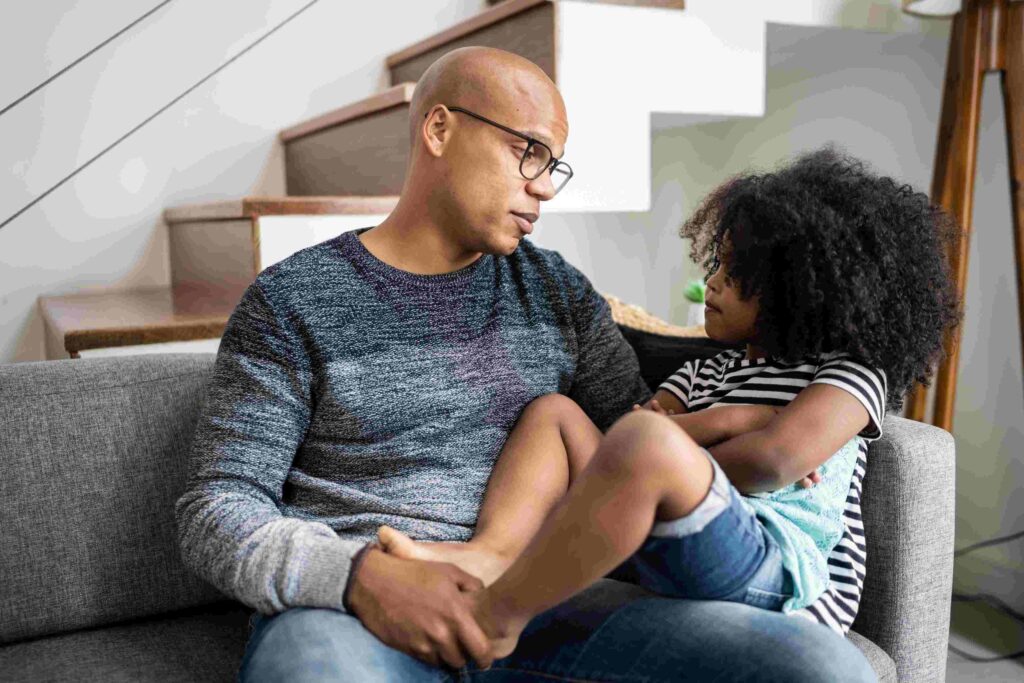Do NOT freeze or cut federal aid!
Will you add your name to the petition to show that we, the people, OPPOSE Trump freezing federal funds that go toward our children, families, schools, and communities?
Sign this Petition
A parent and child talk on their living room couch.
As Thanksgiving approaches, you may start hearing questions and commentary about the history of the holiday—especially from kids—that aren’t rooted in the facts. The often-told story of Thanksgiving is a myth of harmony and an erasure of the genocide that colonists committed against the Wampanoag Tribe in the 1600s. Thanksgiving became a celebrated holiday during the Civil War, likely as a tactic for Abraham Lincoln to unite the North against a common enemy—the South. Indigenous people acknowledge the holiday in various ways. While some Indigenous people consider Thanksgiving a day of mourning, others gather with their families and give thanks.
Thanksgiving has a dark history, often overlooked by mainstream society, that can be difficult to discuss with your children, students, friends, family, and others in your life. As you approach conversations about the holiday, it’s good to go in with a few things first:
Talking about Thanksgiving is hard because everyone has different views, emotions, and thoughts concerning the holiday.
As you endeavor to share your own knowledge and experiences, remember to be open to others’ perspectives as well, and listen to understand, not to respond.
Not enough people are aware of what really happened at the first Thanksgiving. The long-standing legend of “smiling Pilgrims and Wampanoag people happily enjoying a big meal together” has been completely debunked, and light’s been shed on the truth of the Pilgrims’ genocide of the Wampanoag Tribe. In 1970, United American Indians of New England declared Thanksgiving a National Day of Mourning. But other Native Americans and allies celebrate the holiday as part of a long cultural tradition of giving thanks.
There’s no way around it: The reality of Thanksgiving doesn’t exactly make for an easy holiday conversation starter for a day that’s largely been about family, food, and gratitude for many Americans. But living in this country, we are all interconnected, and it’s important to acknowledge this reality and teach the truth of this holiday’s history rather than retell the same harmful stories.
Interrupt the myths and inaccuracies when you hear them. Rather than changing the history people have heard, fill in the gaps. Raise awareness about the systematic displacement of and violence against Indigenous peoples that the United States was founded on. Encourage people to look into the history of the land they inhabit–this Native land map is an amazing educational tool to share. Let people know that Indigenous communities are not of the past. Silence and misinformation about Indigenous people and our country’s origins are, unfortunately, all too common.
So as you prepare to spend time with family and friends, here are some ideas to help you navigate those discussions:
One great approach to discussing or teaching about Thanksgiving is to first ask questions to understand the person’s perspective on the holiday. These questions can be jumping-off points for writing or discussion in the classroom or at the dinner table:
Naturally, young children may not be ready to learn about all the horrific details of Thanksgiving’s history. Instead, Bob Peterson, founding editor of Rethinking Schools and co-editor of Rethinking Columbus, shares, “you can redirect conversation about Thanksgiving to be about what you’re thankful for as a family.”
Once kids reach ages five or six, Peterson says you can share something along the lines of, “The Wampanoag peoples lived in Massachusetts for hundreds of years, but people from Europe came and took their land, and it wasn’t fair.” Older kids are able to learn an in-depth history.
Looking for ways to teach more accurately about Thanksgiving in the classroom? One idea is to ask students to rewrite the Thanksgiving story using historical records and write a poem from the perspective of a person from that time, as Arlington Public School teacher Susannah Remillard had her class do. Kids of all ages can learn that harvest feasts had been part of Wampanoag life much earlier than the 1621 “Thanksgiving feast” with settlers and that giving thanks is a daily practice for many Indigenous people.
You don’t have to wait until Thanksgiving gets here to discuss its truth. And once it’s over, keep the conversation going and continue learning and growing by researching, reading, and discussing history, colonialism, race, and privilege year-round.
Sources and additional resources:
The Real History Behind Thanksgiving
How to Talk to Kids About Thanksgiving
10 Prompts for Talking and Writing About Thanksgiving
How to Tell Your Kids the Truth About Thanksgiving
An Indigenous Peoples’ History of the United States